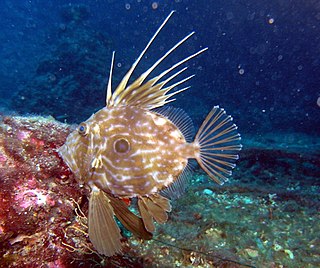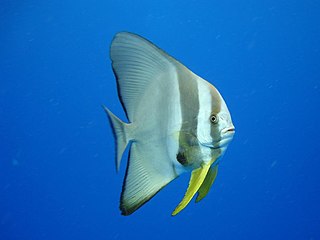
Mackerel is a common name applied to a number of different species of pelagic fish, mostly from the family Scombridae. They are found in both temperate and tropical seas, mostly living along the coast or offshore in the oceanic environment.

Herring are forage fish, mostly belonging to the family of Clupeidae.

Sardine and pilchard are common names for various species of small, oily forage fish in the herring suborder Clupeoidei. The term 'sardine' was first used in English during the early 15th century; a somewhat dubious etymology says it comes from the Italian island of Sardinia, around which sardines were once supposedly abundant.

The Zeiformes are a small order of exclusively marine ray-finned fishes most notable for the dories, a group of common food fish. The order consists of about 33 species in six extant families, mostly deep-sea types. The boarfishes (Caproidae) have been previously included in this order though they are currently included in the Perciformes.

The Gonostomatidae are a family of mesopelagic marine fish, commonly named bristlemouths, lightfishes, or anglemouths. It is a relatively small family, containing only eight known genera and 32 species. However, bristlemouths make up for their lack of diversity with relative abundance, numbering in the hundreds of trillions to quadrillions. The genus Cyclothone is thought to be one of the most abundant vertebrate genera in the world.

Caproidae, or boarfishes, are a small family of marine fishes comprising two genera and 19 species. These fishes are found throughout the world in temperate and tropical seas.

The Grammicolepididae are a small family of deep-sea fishes in the order Zeiformes.. They are called tinselfishes due to their silvery color. They are found near the bottom on the continental slope in the tropical and temperate regions of the Atlantic, Indian and western-central Pacific Oceans. They are of no commercial interest but are sometimes caught in trawls.

Tonguefishes are flatfish in the family Cynoglossidae. They are distinguished by the presence of a long hook on the snout overhanging the mouth, and the absence of pectoral fins. Their eyes are both on the left side of their bodies, which also lack a pelvic fin. This family has three genera with a total of more than 140 species. The largest reaches a length of 66 cm (26 in), though most species only reach half that size or less. They are found in tropical and subtropical oceans, mainly in shallow waters and estuaries, though some species are found in deep sea floors, and even a few in rivers.

Cyttus is the sole genus in the family Cyttidae a family of large, showy, deep-bodied zeiform marine fish. Members of this genus are found in the Atlantic, Indian, and Pacific Ocean.

The silver dory is a dory, in the genus Cyttus, found around southern Australia, on the continental shelf at depths of between 10 and 350 m. Its length is about 40 cm.

Zeus is a genus of fish in the family Zeidae.

Zenopsis is a genus of dories, a group of marine fish. There are five extant species, but the genus is also known from fossils dating back to the Oligocene epoch. They largely resemble the better-known John Dory, and are typically found in relatively deep water, below normal scuba diving depth.

Platax is a genus of Indo-Pacific, reef-associated fish belonging to the family Ephippidae. There are currently five known extant species generally accepted to belong to the genus. They are one of the fish taxa commonly known as "batfish".

An anchovy is a small, common forage fish of the family Engraulidae. Most species are found in marine waters, but several will enter brackish water, and some in South America are restricted to fresh water.

Fish are very diverse animals and can be categorised in many ways. Although most fish species have probably been discovered and described, about 250 new ones are still discovered every year. According to FishBase about 34,800 species of fish had been described as of February 2022, which is more than the combined total of all other vertebrate species: mammals, amphibians, reptiles and birds.
The faceless cusk is a species of cusk-eel. It is the only species of the monotypic genus Typhlonus. It is found in the Indian and Pacific Oceans at depths from about 3,935 to 5,100 m. This species grows to 46.5 cm (18.3 in) in standard length.

Grammicolepis is a monotypic genus of tinselfish, family Grammicolepididae. The only species is Grammicolepis brachiusculus, the thorny tinselfish or deepscale dory. It is found in deep oceanic waters at depths from 250 to 1,026 metres, but usually between 500 and 700 m. It is known from many areas off Australia and occasionally caught as by-catch. Records from northwest Europe include one specimen caught off Scotland in 2004 and one off County Kerry, Ireland in 2010.

The spotbanded scat,(Selenotoca multifasciata), also known as the striped scat, banded scat, barred scat, butterfish, John Dory, Johnny Dory, old maid, Southern butter-fish or striped butterfish, is a species of ray-finned fish, belonging to the family Scatophagidae, the scats. They are found in the eastern Indian Ocean and southwestern Pacific Ocean.















